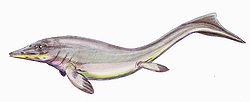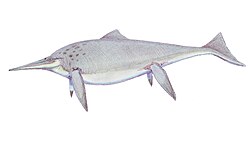| Leptonectes Temporal range: Late Triassic - Early Jurassic, | |
|---|---|
 | |
| skeleton of Leptonectes tenuirostris (NHMUK PV R 498) | |
| Scientific classification | |
| Kingdom: | Animalia |
| Phylum: | Chordata |
| Class: | Reptilia |
| Order: | † Ichthyosauria |
| Family: | † Leptonectidae |
| Genus: | † Leptonectes McGowan, 1996 [1] |
| Species | |
| |
| Synonyms | |
LeptopterygiusHuene, 1929 | |


Leptonectes is a genus of ichthyosaur that lived in the Late Triassic to Early Jurassic (Rhaetian - Pliensbachian). Fossils have been found in Belgium, Germany, Spain and the United Kingdom. [3] [4] [5] A possible specimen from Switzerland first reported in 2006, [6] has been reclassified as that of Hauffiopteryx . [7] The type species, L. tenuirostris, reached 4 metres (13 ft) long, whereas L. moorei (NHMUK PV R 14370) likely reached 3 metres (9.8 ft) long; [8] the largest species, L. solei, was approximately 5–6 metres (16–20 ft) long. [9] [10]







